Can Popular High-Intensity Interval Training (HIIT) Models Lead to Impossible Training Sessions?
Abstract
:1. Introduction
1.1. The Skiba Model
1.2. The Coggan Model
1.3. Practical and Theoretical Value of the Models
2. Materials and Methods
2.1. Fictitious Athletes’ Profiles
2.2. Combinations of HIIT Parameters
2.3. Exhaustion, According to the Skiba Model
2.4. Exhaustion, According to the Coggan Model
3. Results
4. Discussion
4.1. Variations in the Percentage of Impossible Sessions
4.2. Limitations of the Skiba Model
4.3. Limitations of the Coggan Model
4.4. Applicability of the Models
4.5. Limitations
4.6. Future Perspective
5. Conclusions
Author Contributions
Funding
Institutional Review Board Statement
Informed Consent Statement
Data Availability Statement
Conflicts of Interest
References
- Billat, L.V. Interval Training for Performance: A Scientific and Empirical Practice. Sports Med. 2001, 31, 13–31. [Google Scholar] [CrossRef] [PubMed]
- Blondel, N.; Berthoin, S.; Billat, V.; Lensel, G. Relationship between run times to exhaustion at 90, 100, 120, and 140% of vVO2max and velocity expressed relatively to critical velocity and maximal velocity. Int. J. Sports Med. 2001, 22, 27–33. [Google Scholar] [CrossRef] [PubMed]
- Bacon, A.P.; Carter, R.E.; Ogle, E.A.; Joyner, M.J. VO2max trainability and high intensity interval training in humans: A meta-analysis. PLoS ONE 2013, 8, e73182. [Google Scholar] [CrossRef] [PubMed]
- Milanović, Z.; Sporiš, G.; Weston, M. Effectiveness of high-intensity interval training (HIT) and continuous endurance training for VO2max improvements: A systematic review and meta-analysis of controlled trials. Sports Med. 2015, 45, 1469–1481. [Google Scholar] [CrossRef] [PubMed]
- Shiraev, T.; Barclay, G. Evidence based exercise-clinical benefits of high intensity interval training. Aust. Fam. Physician 2012, 41, 960–962. Available online: https://ncbi.nlm.nih.gov/pubmed/23210120 (accessed on 20 November 2021).
- Rosenblat, M.A. Programming Interval Training to Optimize Endurance Sport Performance; University of Toronto TSpace: Toronto, ON, Canada, 2021; Available online: https://tspace.library.utoronto.ca/handle/1807/106260 (accessed on 4 July 2021).
- Buchheit, M.; Laursen, P.B. High-Intensity Interval Training, Solutions to the Programming Puzzle. Sports Med. 2013, 43, 313–338. [Google Scholar] [CrossRef] [PubMed]
- Monod, H.; Scherrer, J. The Work Capacity of a Synergic Muscular Group. Ergonomics 1965, 8, 329–338. [Google Scholar] [CrossRef]
- Morton, R.H.; Billat, L.V. The critical power model for intermittent exercise. Eur. J. Appl. Physiol. 2004, 91, 303–307. [Google Scholar] [CrossRef]
- Péronnet, F.; Thibault, G. Mathematical analysis of running performance and world running records. J. Appl. Physiol. 1989, 67, 453–465. [Google Scholar] [CrossRef] [Green Version]
- Puchowicz, M.J.; Baker, J.; Clarke, D.C. Development and field validation of an omni-domain power-duration model. J. Sports Sci. 2020, 38, 801–813. [Google Scholar] [CrossRef]
- Ferguson, C.; Rossiter, H.B.; Whipp, B.J.; Cathcart, A.J.; Murgatroyd, S.R.; Ward, S.A. Effect of recovery duration from prior exhaustive exercise on the parameters of the power-duration relationship. J. Appl. Physiol. 2010, 108, 866–874. [Google Scholar] [CrossRef] [PubMed] [Green Version]
- Pettitt, R.W. Applying the Critical Speed Concept to Racing Strategy and Interval Training Prescription. Int. J. Sports Physiol. Perform. 2016, 11, 842–847. [Google Scholar] [CrossRef] [Green Version]
- Skiba, P.F.; Chidnok, W.; Vanhatalo, A.; Jones, A.M. Modeling the expenditure and reconstitution of work capacity above critical power. Med. Sci. Sports Exerc. 2012, 44, 1526–1532. [Google Scholar] [CrossRef] [PubMed]
- Skiba, P.F.; Fulford, J.; Clarke, D.C.; Vanhatalo, A.; Jones, A.M. Intramuscular determinants of the ability to recover work capacity above critical power. Eur. J. Appl. Physiol. 2015, 115, 703–713. [Google Scholar] [CrossRef] [PubMed]
- Allen, H.; Coggan, A.R.; McGregor, S. Training and Racing with a Power Meter; VeloPress: Boulder, CO, USA, 2019; 384p. [Google Scholar]
- Hayes, P.R.; Quinn, M.D. A mathematical model for quantifying training. Eur. J. Appl. Physiol. 2009, 106, 839–847. [Google Scholar] [CrossRef] [PubMed]
- Purdy, G. RunningTrax: Computerized Running Training Programs. Prairie Striders Librairie Collection; Tafness Press: Los Altos, CA, USA, 1996; 130p. [Google Scholar]
- Bartram, J.C.; Thewlis, D.; Martin, D.T.; Norton, K.I. Accuracy of W′ Recovery Kinetics in High Performance Cyclists-Modeling Intermittent Work Capacity. Int. J. Sports Physiol. Perform. 2018, 13, 724–728. [Google Scholar] [CrossRef] [PubMed]
- Sreedhara, V.S.M.; Mocko, G.M.; Hutchison, R.E. A survey of mathematical models of human performance using power and energy. Sports Med. Open 2019, 5, 54. [Google Scholar] [CrossRef] [PubMed] [Green Version]
- Muniz-Pumares, D.; Karsten, B.; Triska, C.; Glaister, M. Methodological Approaches and Related Challenges Associated with the Determination of Critical Power and Curvature Constant. J. Strength Cond. Res. 2019, 33, 584–596. [Google Scholar] [CrossRef] [Green Version]
- Poole, D.C.; Burnley, M.; Vanhatalo, A.; Rossiter, H.B.; Jones, A.M. Critical power: An important fatigue threshold in exercise physiology. Med. Sci. Sports Exerc. 2016, 48, 2320–2334. [Google Scholar] [CrossRef] [Green Version]
- Black, M.I.; Jones, A.M.; Blackwell, J.R.; Bailey, S.J.; Wylie, L.J.; McDonagh, S.T.J.; Thompson, C.; Kelly, J.; Sumners, P.; Mileva, K.N.; et al. Muscle metabolic and neuromuscular determinants of fatigue during cycling in different exercise intensity domains. J. Appl. Physiol. 2017, 122, 446–459. [Google Scholar] [CrossRef] [Green Version]
- Jones, A.M.; Vanhatalo, A.; Burnley, M.; Morton, R.H.; Poole, D.C. Critical power: Implications for determination of V O2max and exercise tolerance. Med. Sci. Sports Exerc. 2010, 42, 1876–1890. [Google Scholar] [CrossRef] [PubMed]
- Chorley, A.; Lamb, K.L. The Application of Critical Power, the Work Capacity above Critical Power (W′), and Its Reconstitution: A Narrative Review of Current Evidence and Implications for Cycling Training Prescription. Sportscience 2020, 8, 123. [Google Scholar] [CrossRef]
- Jones, A.M.; Vanhatalo, A. The “Critical Power” Concept: Applications to Sports Performance with a Focus on Intermittent High-Intensity Exercise. Sports Med. 2017, 47, 65–78. [Google Scholar] [CrossRef] [Green Version]
- Vanhatalo, A.; Jones, A.M.; Burnley, M. Application of critical power in sport. Int. J. Sports Physiol. Perform. 2011, 6, 128–136. [Google Scholar] [CrossRef] [PubMed] [Green Version]
- Gorostiaga, E.M.; Sánchez-Medina, L.; Garcia-Tabar, I. Over 55 years of critical power: Fact or artifact? Scand. J. Med. Sci. Sports 2021, 32, 116–124. [Google Scholar] [CrossRef] [PubMed]
- Vandewalle, H. Puissance critique: Passé, présent et futur d’un concept. Sci. Sports 2008, 23, 223–230. [Google Scholar] [CrossRef]
- Caen, K.; Bourgois, J.G.; Bourgois, G.; van der Stede, T.; Vermeire, K.; Boone, J. The reconstitution of W′ depends on both work and recovery characteristics. Med. Sci. Sports Exerc. 2019, 51, 1745–1751. [Google Scholar] [CrossRef] [PubMed]
- Chorley, A.; Bott, R.P.; Marwood, S.; Lamb, K.L. Slowing the Reconstitution of W′ in Recovery with Repeated Bouts of Maximal Exercise. Int. J. Sports Physiol. Perform. 2019, 14, 149–155. [Google Scholar] [CrossRef]
- Leo, P.; Spragg, J.; Podlogar, T.; Lawley, J.S.; Mujika, I. Power profiling and the power-duration relationship in cycling: A narrative review. Eur. J. Appl. Physiol. 2021. [Google Scholar] [CrossRef]
- Hopker, J.; Jobson, S.; Carter, H.; Passfield, L. Cycling efficiency in trained male and female competitive cyclists. J. Sports Sci. Med. 2010, 9, 332–337. Available online: https://ncbi.nlm.nih.gov/pubmed/24149704 (accessed on 20 November 2021).
- Pinot, J.; Grappe, F. Determination of Maximal Aerobic Power from the Record Power Profile to improve cycling training. J. Sci. Cycl. 2014, 3, 26–32. Available online: https://jsc-journal.com/index.php/JSC/article/view/59 (accessed on 20 November 2021).
- Thevenet, D.; Leclair, E.; Tardieu-Berger, M.; Berthoin, S.; Regueme, S.; Prioux, J. Influence of recovery intensity on time spent at maximal oxygen uptake during an intermittent session in young, endurance-trained athletes. J. Sports Sci. 2008, 26, 1313–1321. [Google Scholar] [CrossRef] [PubMed]
- Thevenet, D.; Tardieu-Berger, M.; Berthoin, S.; Prioux, J. Influence of recovery mode (passive vs. active) on time spent at maximal oxygen uptake during an intermittent session in young and endurance-trained athletes. Eur. J. Appl. Physiol. 2007, 99, 133–142. [Google Scholar] [CrossRef] [PubMed]
- Barbosa, L.F.; Denadai, B.S.; Greco, C.C. Endurance Performance during Severe-Intensity Intermittent Cycling: Effect of Exercise Duration and Recovery Type. Front. Physiol. 2016, 7, 602. [Google Scholar] [CrossRef] [Green Version]
- Brickley, G.; Doust, J.; Williams, C.A. Physiological responses during exercise to exhaustion at critical power. Eur. J. Appl. Physiol. 2002, 88, 146–151. [Google Scholar] [CrossRef]
- Hill, D.W.; Smith, J.C. Determination of critical power by pulmonary gas exchange. Can. J. Appl. Physiol. 1999, 24, 74–86. [Google Scholar] [CrossRef]
- Clark, I.E.; Vanhatalo, A.; Thompson, C.; Joseph, C.; Black, M.I.; Blackwell, J.R.; Wylie, L.J.; Tan, R.; Bailey, S.J.; Wilkins, B.W.; et al. Dynamics of the power-duration relationship during prolonged endurance exercise and influence of carbohydrate ingestion. J. Appl. Physiol. 2019, 127, 726–736. [Google Scholar] [CrossRef]
- Morton, R.H. A new modelling approach demonstrating the inability to make up for lost time in endurance running events. IMA J. Manag. Math. 2009, 20, 109–120. [Google Scholar] [CrossRef]
- Faude, O.; Kindermann, W.; Meyer, T. Lactate Threshold Concepts. Sports Med. 2009, 39, 469–490. [Google Scholar] [CrossRef] [PubMed]
- Hawley, J.A.; Myburgh, K.H.; Noakes, T.D.; Dennis, S.C. Training techniques to improve fatigue resistance and enhance endurance performance. J. Sports Sci. 1997, 15, 325–333. [Google Scholar] [CrossRef]
- Stepto, N.K.; Hawley, J.A.; Dennis, S.C.; Hopkins, W.G. Effects of different interval-training programs on cycling time-trial performance. Med. Sci. Sports Exerc. 1999, 31, 736–741. [Google Scholar] [CrossRef]
- Laursen, P.B.; Jenkins, D.G. The Scientific Basis for High-Intensity Interval Training. Sports Med. 2002, 32, 53–73. [Google Scholar] [CrossRef]
- Viana, R.B.; de Lira, C.A.B.; Naves, J.P.A.; Coswig, V.S.; Del Vecchio, F.B.; Gentil, P. Tabata protocol: A review of its application, variations and outcomes. Clin. Physiol. Funct. Imaging 2019, 39, 1–8. [Google Scholar] [CrossRef] [Green Version]
- Tabata, I. Tabata training: One of the most energetically effective high-intensity intermittent training methods. J. Physiol. Sci. 2019, 69, 559–572. [Google Scholar] [CrossRef] [PubMed]
- Gibala, M.J.; McGee, S.L. Metabolic adaptations to short-term high-intensity interval training: A little pain for a lot of gain? Exerc. Sport Sci. Rev. 2008, 36, 58–63. [Google Scholar] [CrossRef] [PubMed]
- Gibala, M.J.; Little, J.P.; Macdonald, M.J.; Hawley, J.A. Physiological adaptations to low-volume, high-intensity interval training in health and disease: Adaptations to low-volume, high-intensity interval training. J. Physiol. 2012, 590, 1077–1084. [Google Scholar] [CrossRef] [PubMed]
- Gibala, M.J.; Gillen, J.B.; Percival, M.E. Physiological and health-related adaptations to low-volume interval training: Influences of nutrition and sex. Sports Med. 2014, 44 (Suppl. S2), S127–S137. [Google Scholar] [CrossRef] [Green Version]
- Gibala, M.J.; Little, J.P. Physiological basis of brief vigorous exercise to improve health. J. Physiol. 2020, 598, 61–69. [Google Scholar] [CrossRef] [PubMed]
- Seiler, S.; Jøranson, K.; Olesen, B.V.; Hetlelid, K.J. Adaptations to aerobic interval training: Interactive effects of exercise intensity and total work duration. Scand. J. Med. Sci. Sports 2013, 23, 74–83. [Google Scholar] [CrossRef]
- Ingham, S.A.; Fudge, B.W.; Pringle, J.S. Training distribution, physiological profile, and performance for a male international 1500-m runner. Int. J. Sports Physiol. Perform. 2012, 7, 193–195. [Google Scholar] [CrossRef]
- Toubekis, A.G.; Smilios, I.; Bogdanis, G.C.; Mavridis, G.; Tokmakidis, S.P. Effect of different intensities of active recovery on sprint swimming performance. Appl. Physiol. Nutr. Metab. 2006, 31, 709–716. [Google Scholar] [CrossRef] [PubMed]
- Broxterman, R.M.; Skiba, P.F.; Craig, J.C.; Wilcox, S.L.; Ade, C.J.; Barstow, T.J. W′ expenditure and reconstitution during severe intensity constant power exercise: Mechanistic insight into the determinants of W′. Physiol. Rep. 2016, 4, e12856. [Google Scholar] [CrossRef]
- Skiba, P.F.; Clarke, D.; Vanhatalo, A.; Jones, A.M. Validation of a novel intermittent W′ model for cycling using field data. Int. J. Sports Physiol. Perform. 2014, 9, 900–904. [Google Scholar] [CrossRef] [PubMed]
- Shearman, S.; Dwyer, D.; Skiba, P.; Townsend, N. Modeling Intermittent Cycling Performance in Hypoxia Using the Critical Power Concept. Med. Sci. Sports Exerc. 2016, 48, 527–535. [Google Scholar] [CrossRef] [PubMed] [Green Version]
- Wallace, L.K.; Slattery, K.M.; Coutts, A.J. A comparison of methods for quantifying training load: Relationships between modelled and actual training responses. Eur. J. Appl. Physiol. 2014, 114, 11–20. [Google Scholar] [CrossRef] [PubMed]
- Banister, E.W.; Calvert, T.W.; Savage, M.V.; Bach, T. A systems model of training for athletic performance. J. Sci. Med. Sport 1975, 7, 57–61. [Google Scholar]
- Foster, C.; Hector, L.L.; Welsh, R.; Schrager, M.; Green, M.A.; Snyder, A.C. Effects of specific versus cross-training on running performance. Eur. J. Appl. Physiol. Occup. Physiol. 1995, 70, 367–372. [Google Scholar] [CrossRef]
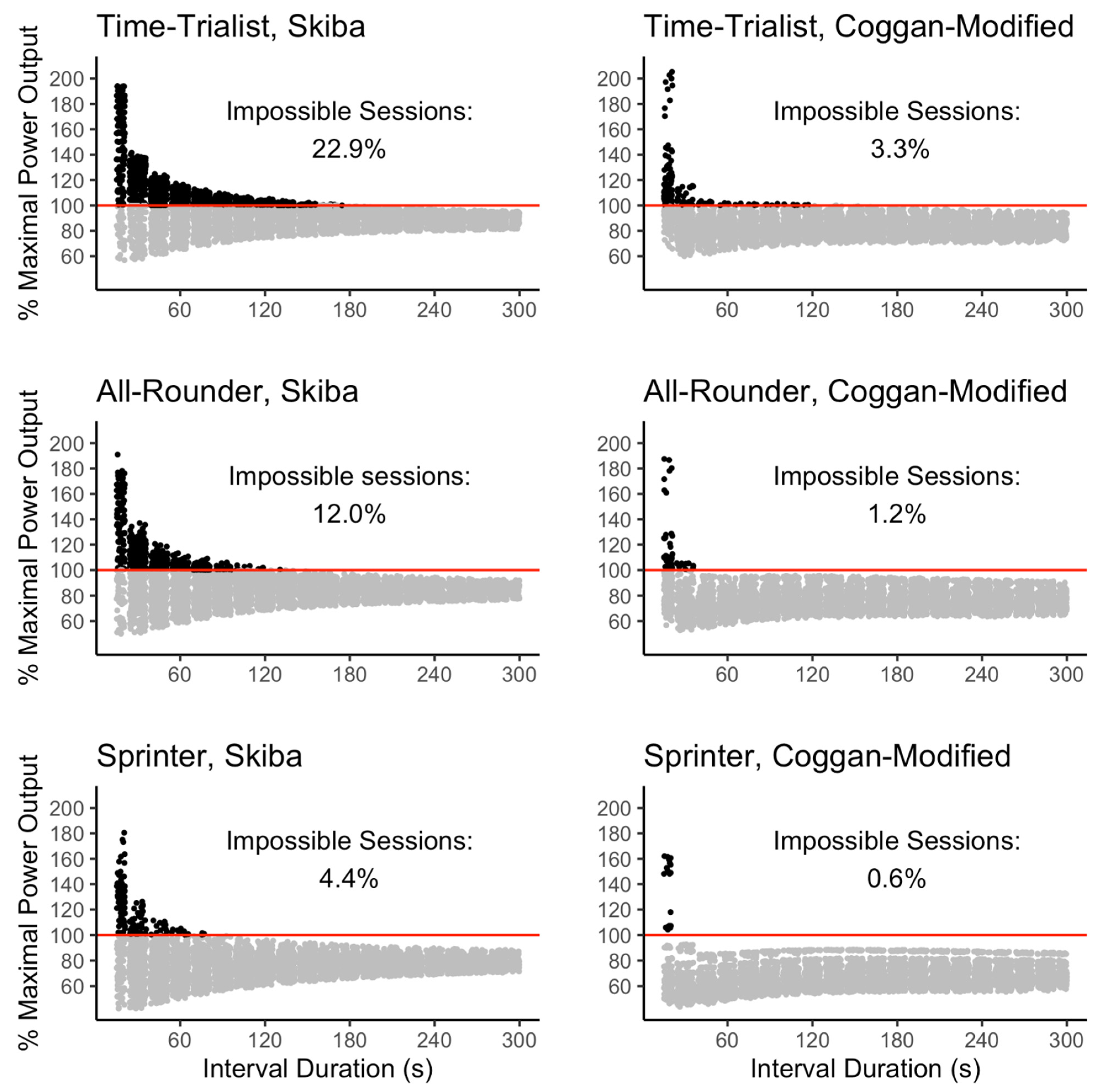
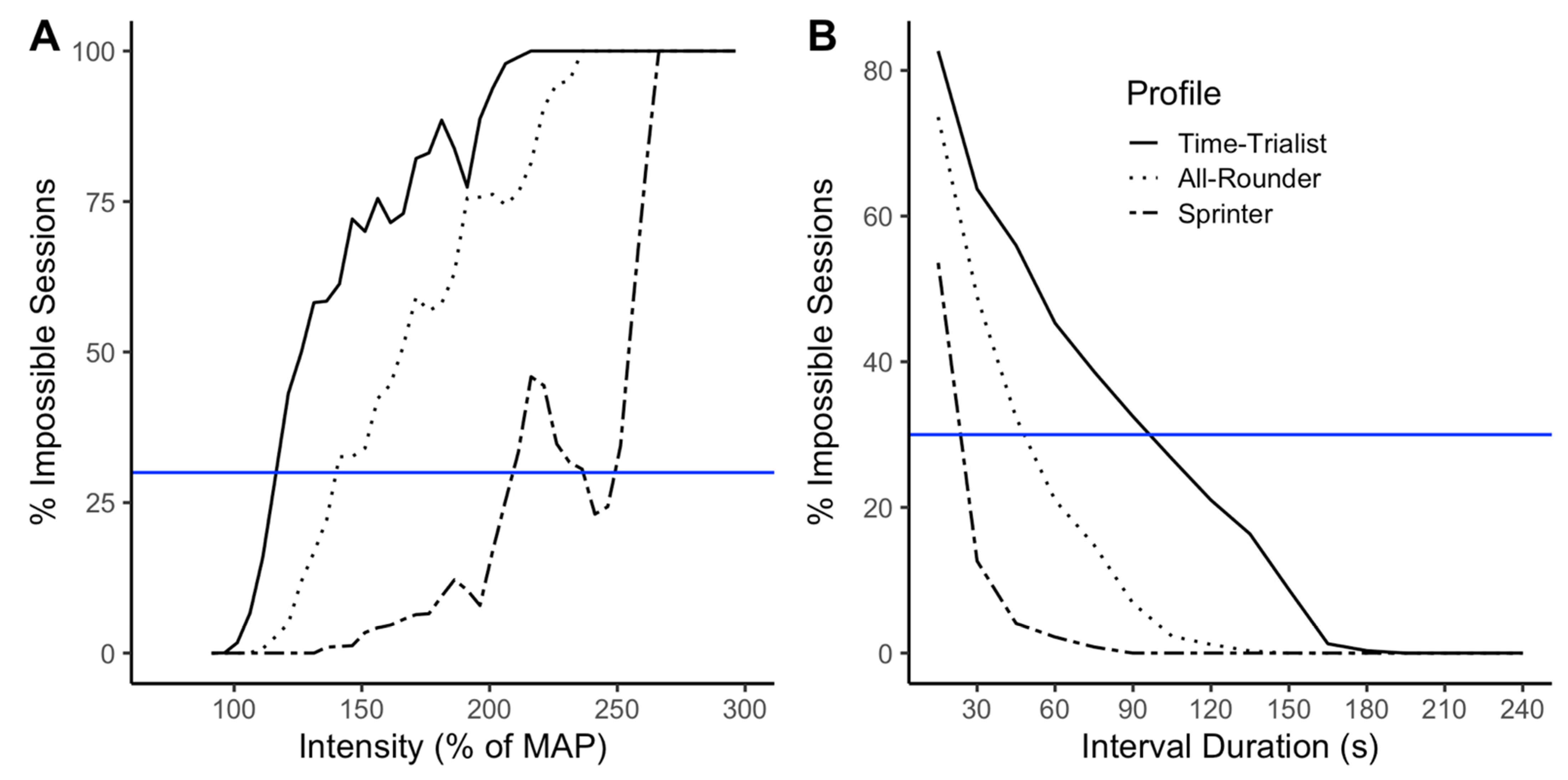
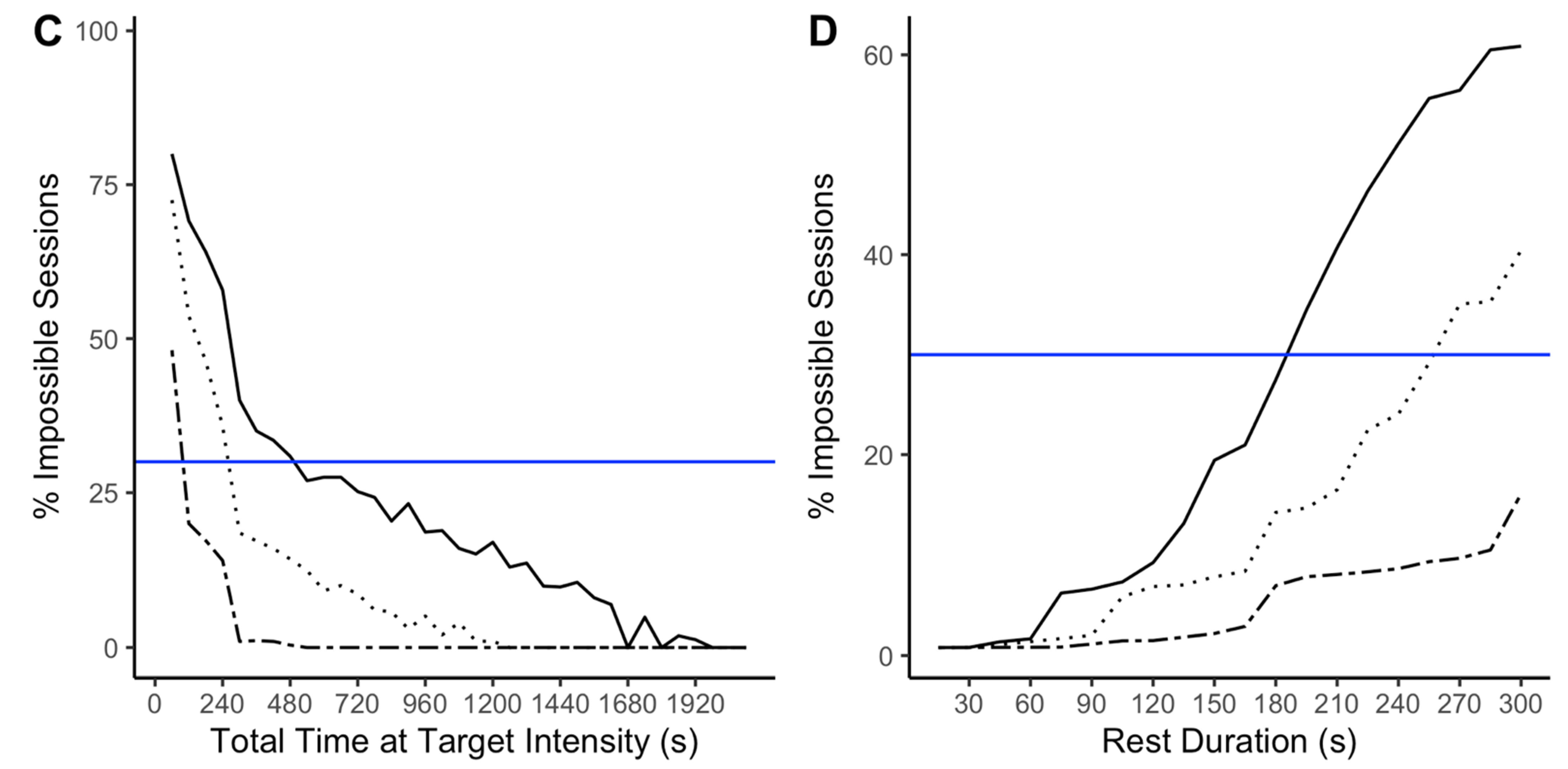
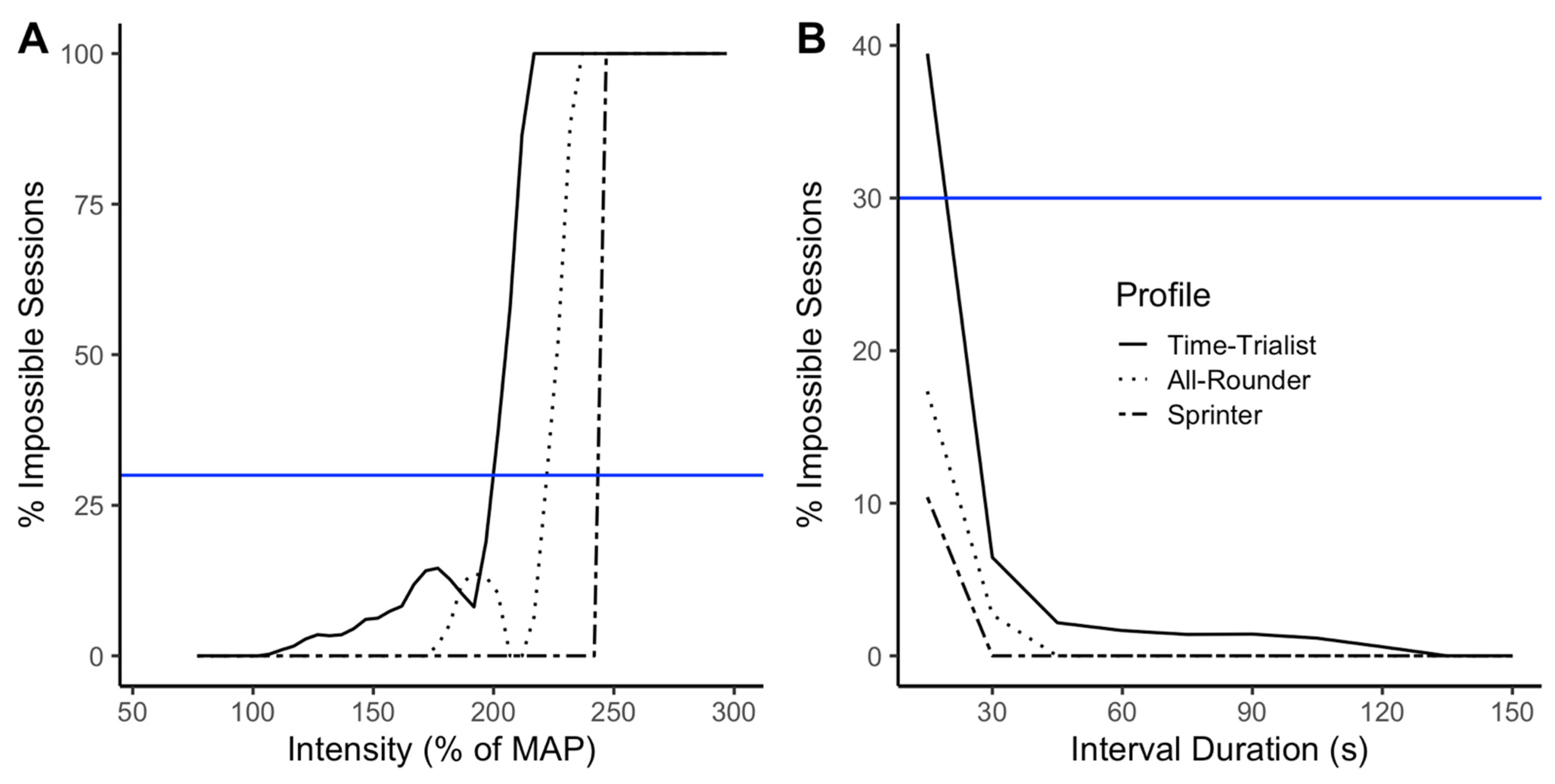
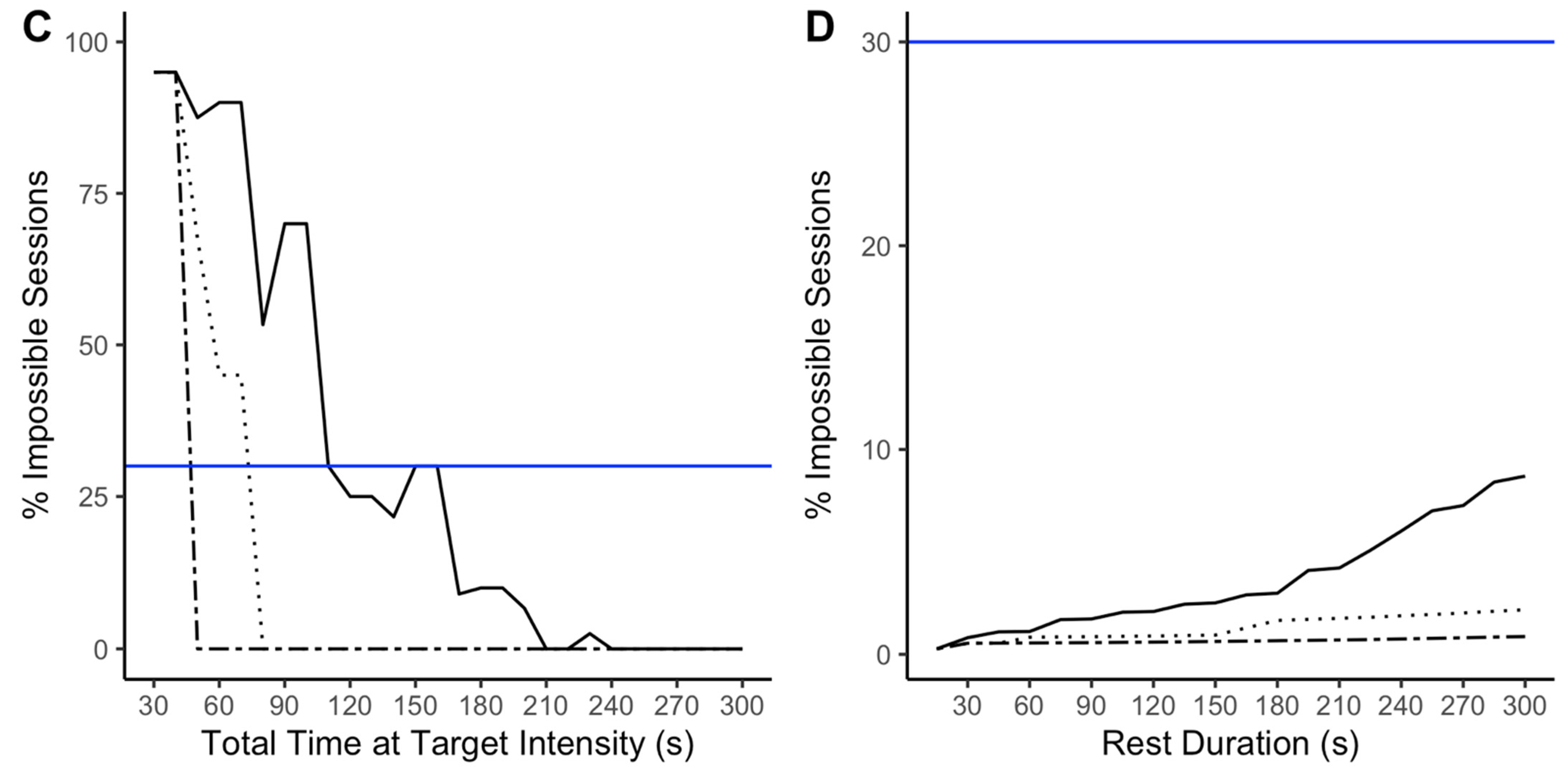
| Profile | Endurance | Anaerobic Capacity (J/kg) | MAP (W/kg) | Critical Power (CP; W) | Anaerobic Reserve (W′; kJ) |
|---|---|---|---|---|---|
| Time-Trialist | −8 | 1400 | 25 | 304 | 21.5 |
| All-Rounder | −10 | 1600 | 25 | 293 | 27.1 |
| Sprinter | −12 | 1800 | 23 | 259 | 32.3 |
| Performance Duration | Sprinter (W) | All-Rounder (W) | Time-Trialist (W) |
|---|---|---|---|
| 1 s | 1251 | 1115 | 978 |
| 15 s | 968 | 876 | 777 |
| 30 s | 782 | 719 | 647 |
| 45 s | 665 | 623 | 567 |
| 1 min | 589 | 561 | 516 |
| 2 min | 457 | 454 | 431 |
| 3 min | 411 | 419 | 403 |
| 4 min | 389 | 402 | 390 |
| 5 min | 375 | 391 | 382 |
| 10 min | 317 | 341 | 342 |
| 20 min | 276 | 307 | 315 |
| 30 min | 257 | 290 | 301 |
| 45 min | 239 | 274 | 289 |
| 60 min | 227 | 264 | 281 |
| 90 min | 211 | 249 | 269 |
| 2 h | 199 | 239 | 261 |
| 4 h | 172 | 214 | 241 |
Publisher’s Note: MDPI stays neutral with regard to jurisdictional claims in published maps and institutional affiliations. |
© 2022 by the authors. Licensee MDPI, Basel, Switzerland. This article is an open access article distributed under the terms and conditions of the Creative Commons Attribution (CC BY) license (https://creativecommons.org/licenses/by/4.0/).
Share and Cite
Briand, J.; Tremblay, J.; Thibault, G. Can Popular High-Intensity Interval Training (HIIT) Models Lead to Impossible Training Sessions? Sports 2022, 10, 10. https://doi.org/10.3390/sports10010010
Briand J, Tremblay J, Thibault G. Can Popular High-Intensity Interval Training (HIIT) Models Lead to Impossible Training Sessions? Sports. 2022; 10(1):10. https://doi.org/10.3390/sports10010010
Chicago/Turabian StyleBriand, Jérémy, Jonathan Tremblay, and Guy Thibault. 2022. "Can Popular High-Intensity Interval Training (HIIT) Models Lead to Impossible Training Sessions?" Sports 10, no. 1: 10. https://doi.org/10.3390/sports10010010
APA StyleBriand, J., Tremblay, J., & Thibault, G. (2022). Can Popular High-Intensity Interval Training (HIIT) Models Lead to Impossible Training Sessions? Sports, 10(1), 10. https://doi.org/10.3390/sports10010010






